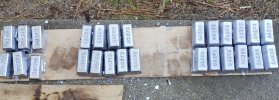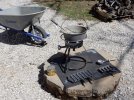Okay guys, Ive got a large heavy propane burner and about 65 lbs of coww and soww, separated. Verified all are lead with a pair of wire cutters on every piece...I finally got the last piece I needed which is an old large round cast iron pot (with lid). My question is pot preparation. It was used for cooking previously and is greasy, etc. What steps should I take to prepare the pot for melting, along with maintenance of it? I plan to melt the coww and soww separately and mark them accordingly btw. Thanks!
You are using an out of date browser. It may not display this or other websites correctly.
You should upgrade or use an alternative browser.
You should upgrade or use an alternative browser.
Melting pot preparation
- Thread starter TomSp8
- Start date
D Crockett
Member
TomSp8 what ever you do do not hit the side of that cast iron pot with your lydle when hot I did mine many years ago and a thin stream of lead came out made one heck of a mess if you want I will make you a steel pot just for the cost of shipping they are a lot safer then cast iron pots pm me if you would like to have one D Crockett
And here is my first ever attempt at melting for ingots. Pretty ugly....but I guess looks arent everything or I never woulda got my wife! lol. I separated each session with clip on wheel weights, stick on wheel weights, then a big chunk of lead pipe I'd had laying around inside my shop for 5 years or so, and I will mark each ingot with a sharpy. Fluxed several times each session with sawdust from the table saw. Finally purchased a thermometer, and kept the temp at about 700 degrees or so. Wore a respirator as well, with all the crud burning off. Pretty messy operation! And glad to be done with that for now. But satisfyiing. Any further comments or advise ?

Attachments
Petrol & Powder
Well-Known Member
/\ THIS /\I like to mark lead with stamps.........I have a letter/number stamp set but a simple cold chisel and a legend that tells you what each mark means would do nicely. Sharpy wears off with handling of the ingots.
I also use letter stamps to mark ingots. It's simple, quick, permanent, and effective.
Once you cast an ingot the composition of the alloy is known only to you and only as long as you can keep track of that one ingot. After they are cast, they all look alike.
Considering the amount of time we typically store our supply of alloys, and the amounts we sometimes store, the only guaranteed way to identify them is to mark them.
You could differentiate them by using different ingot molds for each alloy but even that would require a chart to match ingot types to alloys. It is far simpler to just stamp the things as soon as they harden. That takes all the guess work out and is permanent.
Michael
Active Member. Uh/What
My ingots are identified using the Krylon method. Pure Pb is plain. All the others, pick your color, line 'em up and spray, doesn't wear off. If you think far ahead enough and match the paint color with the PC color that is going to be used the end result will be the PC sticking better and with more uniform coverage and deeper color.
Last edited:
ChestnutLouie
Active Member
D Crocket,TomSp8 what ever you do do not hit the side of that cast iron pot with your lydle when hot I did mine many years ago and a thin stream of lead came out made one heck of a mess if you want I will make you a steel pot just for the cost of shipping they are a lot safer then cast iron pots pm me if you would like to have one D Crockett
With what do you make make your steel WW melting pots with?
I cut the bottom off a helium party balloon tank but it seemed to be to thin.
Maybe I could cut the bottom off of a harbor freight 5gal portable air tank.
thanks
Francis
D Crockett
Member
get a old 20 gal propane tank step 1 get the valve out you might have to take it to a gas CO. to do that what ever you do DO NOT BEAT OR PUT ANY KIND OF SAW ON IT THAT WILL MAKE SPARKS STEP 2 put in 1/4 bottle of Dawn dish soap then fill with water step 3 waite 3 days or more to purge the gas out of the tank Step 4 cut in 1/2 with a side grinder with a metal cutting blade in it you can get a cheap side grinder at horbor freight less than $20 bucks do these 4 steps and you will have a lead melting pot that will last you a life time mine is over 25 years old do this and you willl not get hurt don't and you can get hurt be safe D Crockett
Petrol & Powder
Well-Known Member
D Crockett's method is close to my method.
Remove the valve. That is the toughest part.
Fill the tank with water. Which means completely full so that there is no room for anything else in the tank. (I don't bother to add dish soap but it will not hurt if you do).
I like to dump the water out a re-fill it just for good measure.
Drain the tank and cut it apart near the seam. There is a little overlap near the seam where the two halves of the tank come together, so it helps if you get above or below that joint so you don't have to cut twice as much metal.
Remove the valve. That is the toughest part.
Fill the tank with water. Which means completely full so that there is no room for anything else in the tank. (I don't bother to add dish soap but it will not hurt if you do).
I like to dump the water out a re-fill it just for good measure.
Drain the tank and cut it apart near the seam. There is a little overlap near the seam where the two halves of the tank come together, so it helps if you get above or below that joint so you don't have to cut twice as much metal.
blackthorn
Active Member
This is how I made mine-----A pot can be made from an old 20-pound propane cylinder. Screw out the valve, fill the tank with water, and use a zip-cut tool to cut a larger hole in the top of the tank. Next, dump out the water, lay the tank on its side and cut around the circumference close to the "shoulder" on the tank. I welded a large steel washer to either side of the tank so that a 1" steel rod can be slid through and used to support the vey heavy, lead filled tank using jack stands. I also made a lid and formed a pouring spout in the middle of the tank rim at equal distance between the afore mentioned washers. A makeshift burner for running the pot can be made using a Tiger torch, a 45-degree steel, galvanized or cast pluming elbow and 4 cement building blocks. Place the elbow on the ground, held in place by the 4 blocks. Set the tank over the hole in the middle of the blocks and place the tiger torch in the lower end of the elbow. Fill (or whatever) the pot with scrap, light the torch and away you go. Be prepared to dip the melted metal out of the tank---you for sure will not lift it to pour! Have fun!



